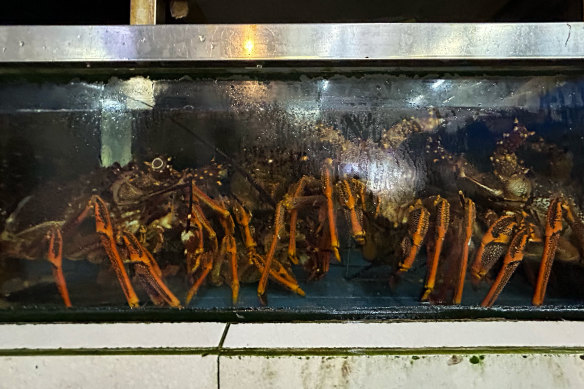
On Thursday, Prime Minister Anthony Albanese announced lobsters would make their triumphant return to China in time for Chinese New Year celebrations in January, after Beijing agreed to lift its trade sanctions.
Unofficially, the crustacean has for years been slipping through border controls and onto Chinese seafood platters via grey market channels routed through third markets, namely Hong Kong, Taiwan and Vietnam.
There have been numerous Chinese media reports of smugglers being busted by customs police with crates of Aussie lobster while attempting a border run in speedboats and cars – an ignominious fate for the creature that was once so heartily welcomed into China, it accounted for up to 90 per cent of Australia’s export market.
At the Jingshen Seafood Market in southern Beijing, lobsters have spent the blockade years in an identity crisis.
One fishmonger at the Hailicheng Seafood Shop even hints at cases of systemic identity fraud, suggesting that Beijing restaurants boasting of Australian rock lobsters on their menu were, in fact, dishing up their New Zealand relatives.
“[Their lobsters] are not from Australia, but from New Zealand,” he said. “If you look at New Zealand lobsters and Australian ones at the same time, you wouldn’t be able to tell the difference, but I can.”

New Zealand rock lobsters for sale in water tanks at the Jingshen Seafood Market in Beijing.Credit: Sanghee Liu
He insisted his shop did not sell any Australian lobster, and produced a customs document showing his latest shipment hailed from New Zealand, but cryptically suggested those searching for it know where to find it.
“Anyone who knows, knows. If you sell [Australian lobsters] to someone who you don’t know or if government departments investigation finds out, you will be in trouble,” he said.
Smuggled lobsters were delivered nationwide through “various channels” he said, and were available in Shanghai and Guangdong, but “not so much in Beijing”.
One thing is certain: the ban on Australian lobster imports lingered far longer than Australian officials expected. Its removal comes almost a year after Trade Minister Don Farrell expressed hope that it would be lifted by Christmas 2023.
It became a stone around the neck of the Australia-China trade relationship that had otherwise returned to a stable footing. Over the past two years, China has gradually lifted almost $20 billion of coercive sanctions on a slew of other Australian products that were imposed in retaliation to the Morrison government’s push for an inquiry into the origins of the COVID-19 pandemic.
Meanwhile, data on the Australian lobster export trade, collated by the United Nations-affiliated International Trade Centre using ABS statistics, shows the boom in trade to nearby countries since the Chinese ban was imposed.
In July, 63 per cent of Australia’s rock lobster exports went to Hong Kong. That is 34 times the volume exported to Hong Kong in July 2020, before the ban, according to an analysis by Professor James Laurenceson, director of the Australia–China Relations Institute at the University of Technology Sydney.
“This indicates that rather than achieving genuine trade ‘diversification’, most Australian rock lobster exports were still ending up in China. But this is being achieved by routing sales through Hong Kong, Taiwan and Vietnam,” Laurenceson said.
With the Australian rock lobster’s honour now restored, the question turns to how quickly Chinese appetites will resume.
“At the beginning [of the ban], people still had demand for such lobsters, but after waiting for too long they found Boston lobsters as replacement,” the Beijing fishmonger said.
Get a note directly from our foreign correspondents on what’s making headlines around the world. Sign up for the weekly What in the World newsletter here.



























